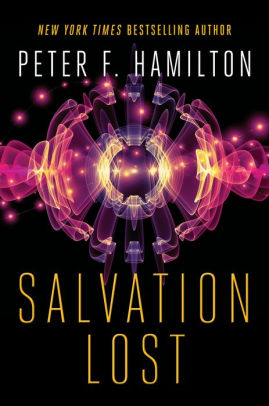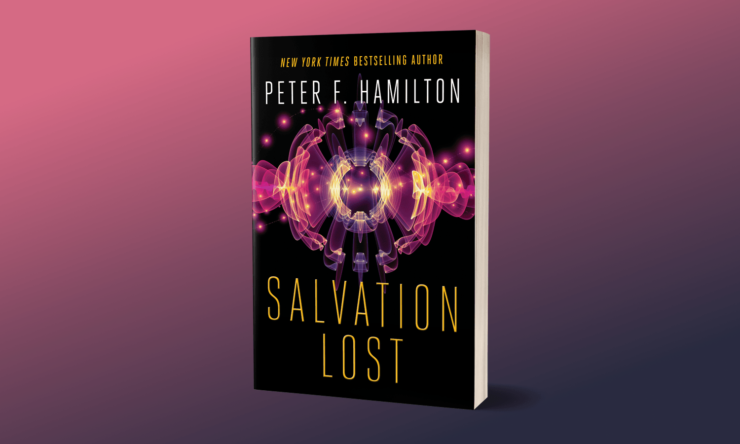Peter F. Hamilton’s Salvation, first in the sequence, created a new universe that resembles his Commonwealth universe; in both, Gate technology proves to be the method of interstellar transport. In many ways, though, the Salvation universe takes the idea and extends it into other facets of life, using gates in a way more reminiscent of Dan Simmons’ Hyperion verse or Larry Niven’s teleportation booths. Salvation’s narrative takes place in two times: in the 23rd century, first contact with the Olyix is not seen immediately as a threat, except by a paranoid few; but in the far future, the danger is all too clear, and the descendants of humanity ruthlessly train themselves and their society to combat the alien threat.
Salvation Lost continues both of those stories in parallel. We know the 23rd century Olyix are going to devestate to humanity—but just how will that play out? And how will the far future conflict resolve?
Salvation Lost falls into the middle book mode of being about the revelation of process, at least at first. That is not to say that the novel doesn’t surprise; the Neána, for instance, arrive in the far future narrative, and there is some really solid plotting and worldbuilding to compare the Neána in the future with their earlier counterparts.
This does point to the abiding strength of the novel, the series, and Hamilton’s writing in general: Strong worldbuilding and extrapolation that considers second and even third order effects of his portal technology, as well as the other technologies in his 23rd century (and his far future timeline) lends itself to page-turning addiction. Even as the Olyix start to move in and try and continue their plan, the counters devised by humanity all evolve cleverly and naturally from the premises of the setting. The relentless invention of his futures are far and away is what readers like me find most appealing in Hamilton’s work, and in a middle volume in a series, he continues to surprise.
Buy the Book


Salvation Lost
The characters can sometimes get lost for me in the giant space of the novel, and the new characters really didn’t resonate and stay sticky for me. The characters held over from the first novel, particularly the members of the Assessment Team and the original Neána, fare better in the second volume, having some more ballast under their feet and to really grow and develop. But honestly, for me, the number of characters in Hamilton’s oeuvre that have stuck with me have been relatively few and far between, and I go into a Hamilton novel focused on his strengths as a worldbuilder. But I say all this for readers who might be curious about Hamilton’s work—if your major interest is deep dives into characters in a SF environment, you are often going to be disappointed. The characters are not cardboard—they have arcs, goals, hopes and dreams—but there are authors who much more keenly highlight those than what Hamilton manages.
The novel ends a bit frustratingly and a bit short of what I felt would be the natural stopping point. Given the pacing of the first novel, I was expecting the novel’s narrative momentum, particularly in the Olyix invasion “present” to get a point that the novel doesn’t quite reach, which unfortunately plays a bit to the “treading water” problem that a lot of middle novels in trilogies can face. The novel isn’t lacking in events, story, or just plain length, but I think the novel could have focused a bit better and gotten to a more pleasing narrative point by the end, rather than coming to a more arbitrary stopping point.
The main question that readers need answered is this: Did I, having invested time in the first novel, find a good ROI for my time and reading effort in this second novel? Yes, yes I did. The novel isn’t perfect but I really found the second novel an excellent continued dive into a universe which has a similar tech premise to the Commonwealth verse, but takes it in new and interesting directions on a number of axes. And the question for readers who haven’t read Salvation: Does Salvation Lost alter my enthusiasm of that first novel and now second novel for you, the reader? For the reader new to Hamilton, if you want giant wide screen space opera with interesting technology and extrapolations of the implications of same, Hamilton is one of the guiding lights of that strand of space opera, and the Salvation novels are a very good place to try his work for the first time.
Salvation Lost is available in the U.S. with Del Rey, and in the U.K. with Pan Macmillan.
Read an excerpt from the novel here.
An ex-pat New Yorker living in Minnesota, Paul Weimer has been reading sci-fi and fantasy for over 30 years. An avid and enthusiastic amateur photographer, blogger and podcaster, Paul primarily contributes to the Skiffy and Fanty Show as blogger and podcaster, and the SFF Audio podcast. If you’ve spent any time reading about SFF online, you’ve probably read one of his blog comments or tweets (he’s @PrinceJvstin).










